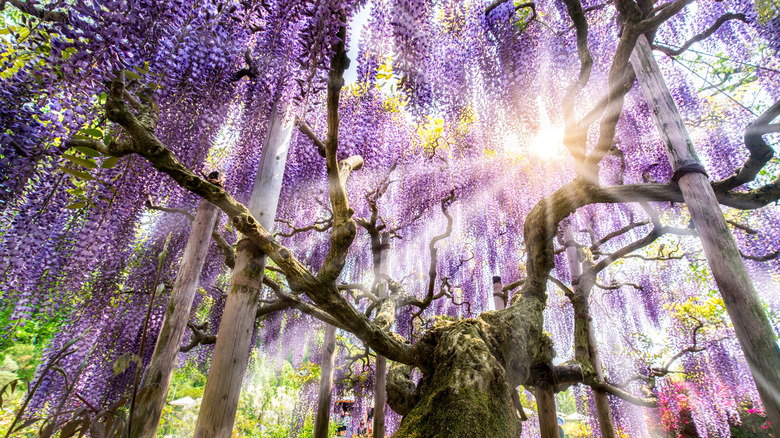Garden Trees, Shrubs & Vines
Rose Okeke
Wisteria is considered to be one of the most beautiful plants you’ll ever see. With its long, intertwined vines and beautiful, hanging purple flowers, Wisteria is truly a magical sight to behold. However, before you go planting this tree in your yard to watch it grow right over your bare feet like Taylor Swift, you might want to think twice.
There are four distinct species of Wisteria with one of them, Wisteria frutescens, being a native of North America. However, because most people prefer the boisterousness and beauty of the exotic Wisteria from places like China (Wisteria sinensis), some of them were introduced into the country. Although this tree is gorgeous, it comes at a very steep price — it’s widely considered to be an invasive species. This means that it will out-compete with local plants in the ecosystem for resources and nutrients, subjecting those other plants to certain death. Also, the way that Wisteria grows causes direct harm to other plants. It is a climbing vine that latches itself tightly onto virtually anything, pulling itself up as it goes. In the process, its determined vines can suffocate the plant or tree in its grip. It causes so much physical damage that it eventually kills the plant, no matter how large the trunk may be.
When it comes to growing Wisteria in your yard, you may want to sit this one out. However, If you are hellbent on having Wisteria in your garden, then you should know its dos and don’ts to prevent it from hurting other species in the environment.
How to plant wisteria without damaging other plants

mapman/Shutterstock
The first step in growing Wisteria successfully is choosing the right species. The more sought-after species like the Chinese or even the Japanese Wisteria tend to be more destructive and less tame. The North American variety is your best bet for an easier-to-manage experience, so stick to that.
Wisteria needs regular pruning twice a year — once in the summer, and again in wintertime. According to Gardenologist, you should snap off the growth from your plant two months after it stops blooming in the summer, and then again right before winter turns to spring. This encourages better blooming during the new flowering seasons.
You can also practice companion planting by pairing your Wisteria with a compatible plant to grow with. Since Wisteria is notoriously aggressive, it could do with an equally aggressive friend. Garden designer David Chanell told Gardening Etc. that he groups his Wisteria with evergreen honeysuckles. “[It keeps] the foliage coverage in winter if the climbers are required to cover an unsightly backdrop,” he explained.
Finally, location matters when planting Wisteria because the roots are just as wild as the vines. If left unchecked, these climbing vines can damage your home by twining onto it while their roots disturb the foundation and plumbing, not to mention the roots of other plants in the area. Once you know how to grow and care for your Wisteria tree, you can manage its excesses and have a beautiful lavender yard, too.




